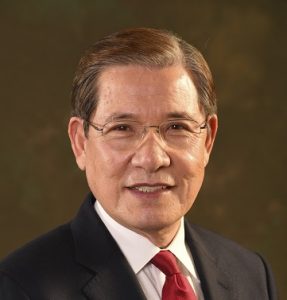![U.S. President Donald Trump delivers remarks on tariffs in the Rose Garden at the White House in Washington, D.C., U.S., April 2, 2025. [REUTERS]](https://www.koreadailyus.com/wp-content/uploads/2025/04/0402-Tariffs.jpg)
An initial assessment of the newly announced reciprocal tariffs to counter both tariff and non-tariff barries with the minimum tariff of 10 percent suggests a modest drag on economic growth and a slight uptick in inflation over the next 12 months.
However, despite these headwinds, there is no indication of an impending recession or the onset of stagflation over the next twelve months. Based on the updated projections, real GDP is expected to decline by approximately 0.2 percentage points relative to the pre-announcement baseline, and the inflation rate is anticipated to rise by a similar margin—0.2 percentage points.
The prior baseline scenario already incorporated some expectations of these tariffs (see attached table for reference).
Several key factors help explain the resilience of the U.S. economy in this context:
1. The Dominance of Services in the U.S. Economy
Over 80% of U.S. GDP is driven by the services sector, which remains largely unaffected by tariffs that primarily target goods. This sectoral composition significantly cushions the broader economy from the full impact of trade-related disruptions.
2. Tariffs Represent a One-Time Price Adjustment, Not Ongoing Inflation
While tariffs do raise the prices of certain imported goods, this constitutes a one-off adjustment rather than a sustained, broad-based increase in prices. Inflation, by definition, involves a continuous rise in prices over time. Therefore, while headline inflation may tick upward temporarily, underlying inflationary pressures remain limited.
3. USMCA Provides a Buffer for North American Trade
Roughly 50% of U.S. trade with Canada and Mexico is shielded from these tariff impacts thanks to the United States-Mexico-Canada Agreement (USMCA). This trade agreement preserves preferential treatment for a significant share of North American commerce, mitigating potential supply chain disruptions and cost increases.
4. Asymmetrical Impact on Trade Partners
Compared to the United States, many of our trading partners—particularly export-driven economies—are more reliant on trade as a share of their GDP. Consequently, they may be less inclined to engage in full-scale retaliation. In many cases, foreign exporters may absorb some of the tariff-related costs in order to maintain market access in the U.S., further dampening the potential inflationary effect.
5. Offsetting Policy Stimuli: Tax Cuts and Deregulation
Simultaneously, a range of expected tax cuts—including those on tips, Social Security earnings, and capital depreciation—along with ongoing deregulation efforts, are expected to bolster business investment and job creation. These pro-growth measures will help offset the drag from tariffs, supporting continued expansion in domestic demand. In addition, President Trump announced over $6 trillion in investments by major corporations. Some of it will materialize.
6. Policy Certainty Provides a Stabilizing Effect
Provided that the current tariff regime remains stable and no additional duties are introduced, the reduction in policy uncertainty can have a stabilizing effect on financial markets and business planning. Historically, markets respond more negatively to unpredictability than to adverse but clearly defined policies. Greater clarity—even if not favorable—helps businesses and investors make informed, confident decisions.
In sum, while today’s tariff announcement introduces certain economic challenges, the structure of the U.S. economy, combined with strategic trade agreements and supportive domestic policies, makes a sharp downturn or inflationary spiral unlikely. The U.S. remains well-positioned to absorb this shock and continue on a path of moderate, stable growth.
 By Sung Won Sohn
By Sung Won Sohn
The author is professor of finance and economics at Loyola Marymount University and president of SS Economics. He was executive vice president at Wells Fargo Banks and senior economist on the President’s Council of Economic Advisors in the White House.


![Hangar images indicate North Korean advances in military drone domain Satellite photos taken on March 28, included in Beyond Parallel's report on North Korea, shows what appears to be seven new drone hangars at the Banghyon Air Base. [SCREEN CATPURE]](https://www.koreadailyus.com/wp-content/uploads/2025/04/0402-Hangar-100x70.jpg)

![Deeper-I, Efinix sign deal to develop world’s first AI-FPGA single-chip solution Ikuo Nakanishi, left, vice president of sales at Efinix and Lee Sanghun, right, CEO of Deep-I pose for a photo after signing MOU on March 26. [Provided by Deeper-I]](https://www.koreadailyus.com/wp-content/uploads/2025/04/0401-DeeperI-100x70.png)